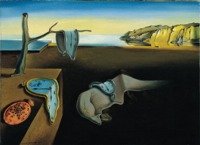
Making generalizations about the
visual culture of any group
of people is a crude endeavor, especially with a culture as diverse![]() as Spain's. With this thought in mind,
know that this survey, as any must be, is tremendously limited
in its breadth and depth.
as Spain's. With this thought in mind,
know that this survey, as any must be, is tremendously limited
in its breadth and depth.
[Expect a more in-depth article to appear here soon.]
Examples:
Bienvenido - Esta página esta bajo construción. Por favor visítenos próximamente.

Spain, Parade Helmet in Hispano-Moresque style,
late 15th-early 16th century, steel,
inlaid with gold, precious stones; fish skin; length
37 7/8 inches (96.1 cm), Metropolitan Museum of Art, NY. See
arms &
armor.

José (Jusepe) de Ribera (Spanish, 1591-1652), The Holy Family with Saints Anne and Catherine
of Alexandria, 1648, oil
on canvas, 82 1/2 x 60
3/4 inches (209.6 x 154.3 cm), Metropolitan Museum of Art, NY.
(On the Met's page, you can enlarge any detail.)

Francisco de Zurbarán (Spanish, 1598-1664), Saint Francis of Assisi in His Tomb,
c. 1630/34, oil on canvas, Milwaukee Art Museum,
WI.

Francisco de Zurbarán, The Young Virgin, c. 1632-33, oil
on canvas, 46 x 37 inches
(116.8 x 94 cm), Metropolitan Museum of Art, NY. (On the Met's
page, you can enlarge any detail.)

Diego Velázquez (Diego Rodríguez
de Silva y Velázquez) (Spanish, 1599-1660), The Luncheon (Three Men at a Table),
c. 1617/18, oil on canvas, 43 x 40 inches (108.5
x 102 cm), Hermitage Museum, St. Petersburg, Russia.

Diego Velázquez, Prince Baltasar Carlos as a Hunter, 1635-36,
191 x 102 cm, Museo del Prado, Madrid.

Diego Velázquez, King Philip IV of Spain (160565), 1644, oil on canvas, 51 1/8 x 39 1/8 inches (129.8 x 99.4 cm), Frick Collection, NY.

Diego Rodríguez, Juan de Pareja (c. 1610-1670), 1650,
oil on canvas,
32 x 27 1/2 inches (81.3 x 69.9 cm), Metropolitan Museum of Art,
NY. (On the Met's page, you can enlarge any detail.)

Diego
Velázquez, The
Family of Philip IV, or "The Maids of Honor (Las Meninas)", c. 1656, oil
on canvas, (318 x 276 cm),
Prado Museum, Madrid.
 This
is a group portrait
of an exceptional sort:
This
is a group portrait
of an exceptional sort:
In the center-foreground
is the infanta (princess) attended by her meninas (maids of honor) — companions
 including
two young ladies, a dwarf, a child, a dog, a nun, and a tutor.
including
two young ladies, a dwarf, a child, a dog, a nun, and a tutor.
This little party is visiting the studio
where Velázquez stands before his canvas. We see the back of it, perched upon
an easel. The painter
 and
the most of the others look toward the king and queen as they
pose for the painting in progress.
and
the most of the others look toward the king and queen as they
pose for the painting in progress.
The king and queen would not actually be
visible in this picture if their reflected
image could not be seen in a mirror
placed on the opposite wall. Altogether this is a view, which
could only be seen by the king and queen themselves, as
 they pose for their
portrait. The point of view
of every person who gazes
upon this painting is that of the king and queen of Spain. A
very privileged vantage indeed!
they pose for their
portrait. The point of view
of every person who gazes
upon this painting is that of the king and queen of Spain. A
very privileged vantage indeed!
Further
increasing the sense that we are present at a specific moment
is our glimpse of a man in the distant doorway, pausing as he
descends or ascends — either entering or exiting the chamber.
See Baroque,
detail, genre, and self-portrait.
In the manner of Diego Velázquez de Silva, Dona Mariana of Austria, Queen of Spain, 1649, oil on canvas, 27 3/8 x 22 inches, Legion of Honor, San Francisco.
Bartolomé Esteban Murillo (Spanish, 1618-1682)
![]()
Luisa Roldán (Spanish, 1650-1704),
sculptor; Luis Antonio de los Arcos, polychromer, gilder, St. Ginés de la Jara, about 1692,
polychromed wood
(pine and cedar) with glass eyes,
height 69 1/4 inches (176 cm), J. Paul Getty Museum, Malibu,
CA.

Francisco José de Goya y Lucientes
(Spanish, 1746-1828), Condesa de Altamira and Her Daughter, Maria Agustina,
1787-1788, oil on canvas,
76 7/8 x 45 1/4 inches (195 x 115 cm), Metropolitan Museum of
Art, NY. See Romanticism.

Francisco José de Goya y Lucientes, Don Manuel Osorio Manrique de Zuñiga (1784-1792),
possibly 1790s, oil on
canvas, 50 x 40 inches
(127 x 101.6 cm), Metropolitan Museum of Art, NY. (On the Met's
page, you can enlarge any detail.) See signature.

Francisco José de Goya y Lucientes, The
Sleep of Reason Produces Monsters (O Sonho da Razao Produz Monstros),
1796-1797, first edition,
number 43 from the series "Los Caprichos", etching and aquatint.

Francisco
de Goya y Lucientes (Spanish, 1746-1828), Saturn Devouring one of his Sons, mural transferred to canvas,
(146 x 83 cm), Prado Museum, Madrid. Also see etching, expression, grotesque,
mythology, and Romanticism.

Francisco José de Goya y Lucientes, Giant, by 1818, XIX, burnished
aquatint, first
state; sheet: 11 1/4 x 8 1/4 inches (28.5 x 21.01cm), Metropolitan
Museum of Art, NY.

Francisco de Goya y Lucientes (Spanish, 1746-1828), The Forge, between c. 1815 and 1820, oil on canvas, 71 1/2 x 49 1/4 inches (181.6 x 125.1 cm), Frick Collection, NY.
Antoní Gaudí (Spanish, 1852-1926), Casa Batllo, 1905-1907, an apartment building (remodel), concrete, Barcelona, Spain. See architect and architecture.

Antoní Gaudí, Wall clock from the Casa Milá, Barcelona,
1906-1910, gilded wood,
private collection. See Art
Nouveau and horology.

Antoní Gaudí, Sagrada Familia (Church of the Holy Family),
masonry, uncompleted
during Gaudi's lifetime and uncompleted today, though construction
continues. See Expressionism.
Julio Gonzalez (Spanish, 1876-1942)
Pablo Picasso (Spanish, 1881-1973), Les Demoiselles d'Avignon, 1907, oil on canvas, 8' x 7'8" (243.9 x 233.7 cm), in the Museum of Modern Art, New York. This is considered by many the first cubist painting. It was influenced by the paintings by Paul Cézanne and by the fauvists, as well as by African sculptures. The subjects of this picture are actually not women of the city of Avignon, but prostitutes of a street named Avignon. See Cubism.
Pablo Picasso, Head of a Woman (Fernande Olivier), 1909, bronze, height 16 1/4 inches. This was Picasso's first attempt to create three-dimensionally what he had developed two-dimensionally with cubism. As H. H. Arnason said, although it is therefore "historically of the greatest significance as the first step toward an entirely new kind of sculpture — that of construction or assemblage — at this point Picasso had not yet realized the implications of cubism for sculpture." This was exhibited in the influential Armory Show of 1913. See construction and assemblage.
Joan Miró (Spanish, 1893-1983), Painting, 1927, oil on canvas, 116 x 89 cm, Georges Pompidou Center, Paris. See automatism and Surrealism.
Joan Miró, Painting, 1933, oil on canvas, 146 x 114 cm, Georges Pompidou Center, Paris.
Joan Miró, L'objet du couchant (Sleeping Object), summer 1935-1936, painted carob trunk, metal spring, gas burner, chain, manila and string, 68 x 44 x 26 cm, Georges Pompidou Center, Paris.
Joan Miró, Head of a Woman, 1938, oil on canvas, 18 x 21 5/8 inches, Minneapolis Institute of Arts.
Salvador Dalí (Spanish, 1904-1989; active in Paris and New York), Lugubrious Game, 1929, oil on panel, 16 1/2 x 10 1/2 inches, private collection, Paris.

Salvador Dalí, The Persistence of Memory, 1931, oil on canvas, 9 1/2 x 13 inches, Museum of Modern Art, NY. See distortion.
Salvador Dalí, Remorse or Sphinx Embedded in the Sand, 1931, oil on canvas.
Salvador Dalí, Retrospective Bust of a Woman (Buste de femme rétrospectif), 1933, some elements reconstructed 1970, painted porcelain, bread, corn, feathers, paint on paper, 29 x 27 1/4 x 12 5/8 inches (73.9 x 69.2 x 32 cm), Museum of Modern Art, NY. See bust.
Salvador Dalí, Untitled (Petit Theâtre), 1934, wood and glass, painted, 12 3/4 x 16 3/4 x 12 1/4 inches (32.3 x 42.5 x 31.1 cm), Museum of Modern Art, NY.
Salvador Dali (Spanish, 1904-1989), Portrait of Juan de Pareja, the Assistant to Valezquez, 1960, oil on canvas, 29 1/4 x 34 3/4 inches, Minneapolis Institute of Arts. See Surrealism.
Eduardo Chillida (Spanish, 1924-2002), Modulation of Space I, 1963, iron, 54.6 x 69.8 x 40.0 cm, Tate Gallery, London. See sculpture.

Antonio Saura (Spanish, 1930-), Maja, 1957, oil
on canvas, 63 3/4 x 51
1/4 inches, Minneapolis Institute of Arts.
Also see architecture, arms & armor, Art Nouveau, Baroque, costume, Cubism, Dada, degenerate, design, drawing, engraving, etching, fascist aesthetic, flags of Europe, French art, furniture, genre, history painting, illumination, Islamic art, jewelry, landscape, lithography, Madonna, marble, Middle Ages, monument, museum, mythology, narrative art, photography, portrait, propaganda, sculpture, seascape, self-portrait, stained glass, still life, Surrealism, tapestry, and textile, among many other articles.
https://inform.quest/_art